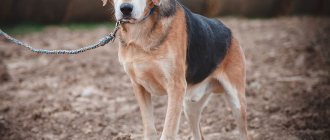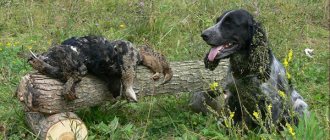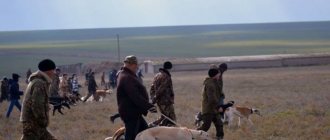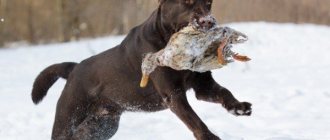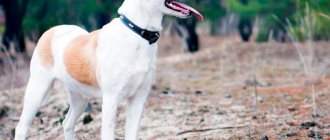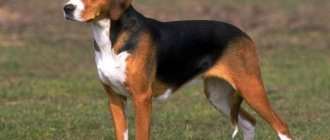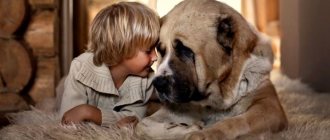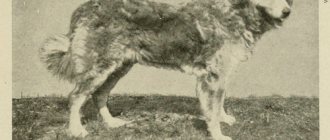Care and maintenance of the Podgalyan Shepherd Dog
The Podgalyan Shepherd Dog requires close attention.
Caring for her takes some time. All dog breeders advise accustoming your pet to all sorts of grooming procedures from a very early age. If you listen to this advice, you can instill in your shepherd not only the habit of various cosmetic procedures required for it, but also force it to live according to a certain daily routine, which is also important. A pet trained from infancy will calmly respond to combing and cleaning its ears as an adult.
A walk outside must always end with washing your paws.
A pet trained from infancy will calmly respond to combing and cleaning its ears as an adult. A walk outside must always end with washing your paws.
If you do this to a small dog, then when it grows up it will never enter the room with unwashed paws. She will stand at the entrance for a long time waiting for help to wash her paws. She will not hesitate to remind about herself.
The white and beautiful coat of a pet also needs serious care, only in this case it will be beautiful. Your dog's fur needs to be brushed at least once a week. During molting, it is advisable to do this more often and thoroughly. The pet's eyes, claws and ears need periodic treatment.
You can keep a pet in an apartment, but it is better to choose a country house for this. If, after all, there is no such opportunity and you really want to have such a dog, then you need to try very hard so that the pet does not get bored. Long walks and jogs, trips to the forest or to a city park will save your dog from boredom.
Podgalians are working dogs. If they strive to help their owner, they should not be restrained or stopped. These pets simply cannot sit in one place; they have so much energy that in order to expend it, the dog simply needs to be constantly on the move. Active play with children, for example, will benefit everyone.
As for nutrition, it should be balanced. Initially, you need to decide what food will be included in your pet’s diet. If it is dry food produced specifically for large breeds of dogs, then it must be fresh and contain a large amount of useful substances.
Once you decide to cook your dog’s food yourself, your diet should include foods containing a sufficient amount of protein. It is found in raw meat, dairy products and eggs.
In the photo there are Podgalyan Shepherd puppies
It is almost impossible to raise a strong and beautiful dog on light soups and porridge alone. Every owner of a white Podgalyan Shepherd dog should understand this.
From the description of the Podgalyan Shepherd Dog breed it is known that its puppies grow relatively quickly
Therefore, great attention must be paid to the dog’s nutrition. In addition to the fact that it must be balanced, it is necessary to clearly define the dosages
Dogs can overeat, which is extremely undesirable. It is imperative to include foods containing calcium in the diet of the Podgalyan Shepherd Dog; it greatly helps in the formation of the dog’s skeleton.
Before training a Podgalyan Shepherd Dog, you first need to decide for what purpose the dog was bred. She is famous for her versatility, being smart and able to catch everything on the fly.
You need to start training from a very early age. Initially, the puppy will be stubborn, but over time he will enjoy the activities. The main thing is for the owner to show strength of character; only such people can these shepherd dogs obey. The trainer must have a sense of tact and patience.
Caring for the Polish Hound
The main difficulty in keeping a hound dog is the need for physical activity. Ogars require long daily walks (at least 2-3 hours), where they can run around and play with their owner and other dogs. A non-aggressive nature usually allows one to avoid conflict situations with relatives. The dimensions allow you to keep the animal both in an apartment and in a private house, but the second option is still preferable - the pet will feel better, having the opportunity to enjoy fresh air if desired. Otherwise, caring for your dog is simple:
- When feeding, you should give preference only to high-quality products. The purchased food should be in the super-premium and holistic categories and be designed for animals with high energy expenditures (for example, Acana Sport & Agility, Monge Dog Specialty Active, Chicopee HNL Active Salmon & Potato). When feeding Polish hunters, it is important to follow the recommendations for portion sizes - the animal’s increased appetite can lead to excess weight. A specialist will help you create a natural diet based on your pet’s characteristics. It will definitely include: lean meat (at least 50%),
- healthy by-products (heart, liver),
- fermented milk products,
- vegetables,
- greenery,
- cereals
To care for the ogar's fur, you need to use a special brush.
We recommend reading: The English Bulldog is a gentleman of the canine world
Maintenance and care
Like most domestic breeds, Russian piebald hounds are adapted to the weather conditions of the Middle Zone. Yes, their wool is poorer than that of Russian hounds, but the animals will be able to spend the winter in a barn or enclosure with an insulated booth without harm to their health. In extreme frosts, it is recommended to temporarily place the dog in a house or any other heated room.
Walking enclosures for Russian piebald hounds must be built in such a way that the animals cannot dig under the ground and break free. It is advisable to make barriers from a metal mesh, which is buried at least half a meter into the ground, laying wooden poles in the place where the metal goes into the soil. Don’t skimp on the height of the walls of the enclosure: 2 meters or no less, if you don’t want to wander around the surrounding forests for days in search of a four-legged fugitive.
Some owners manage to keep Russian piebald hounds in the conditions of a typical city apartment, but such a forced measure should not be taken as an example to follow. Despite the fact that in a home environment, RPGs are calm and balanced, restrictions on freedom of movement and excess heat cause severe discomfort to the animals.
You need to walk a Russian pinto hound a lot and at a pace, so if you are not ready for long runs twice, or better yet, three times a day, buy a bicycle, strap your pet to it and wind kilometers along country roads. The optimal distance for one walk is 5-6 km. You can let your dog off the leash in open spaces and in places where a stray cat or, worse, a wild animal will definitely not appear. Seeing potential prey, the Russian piebald hound immediately turns on the pursuit mode, completely abstracting from the owner and his calls.
Hygiene
If it were not for hunting habits and love for intensive walks, the Russian piebald hound could claim the status of the favorite dog of lazy people, because caring for it is the easiest. Representatives of this breed are rarely bathed and only when absolutely necessary. Puppies are not washed at all until they are three months old, so make sure that your pet has less contact with dirt, otherwise you will have to break the rule. There is also little fuss with the dog’s fur: it is enough to smooth it a couple of times a week with a comb-mitten, removing dead undercoat. During the molting season, the procedure is carried out more often.
But the Russian pinto hound's eyes, which are prone to conjunctivitis, will have to be wiped daily. However, no special skill is required here: just moisten a clean cloth with chamomile infusion or strong tea and walk it along the edges and corners of the eyelids, collecting dust and mucus. Dogs' ears are cleaned in the standard manner: once a week, with a napkin soaked in hydrogen peroxide or heated vegetable oil. Since working hounds have to run a lot and intensely, always check their paws after hunting or walking. Often small objects get stuck between the animal’s toes, which can injure the pads. Once every two months, it is recommended to shorten the claws of the Anglo-Russian hound. This procedure can only be neglected if the pet leads an active lifestyle and manages to sharpen its claws during jogging and hunting trips.
Feeding
The ideal food for Russian pinto is raw, lean meat, supplemented with oatmeal and seasonal vegetables. The amount of food offered depends entirely on the animal's activity level. So, during the hunting season, the daily food intake for RPGs is as follows: 600 g of meat, 500-700 g of oatmeal, 150 g of vegetables (cabbage, carrots), 100 g of potatoes. When the period of forest forays ends, the quota of meat and potatoes is cut by a third, while maintaining the original volume of cereals and vegetables.
For variety and to save money, it is advisable to replace meat with offal and sea fish with previously removed bones. However, due to the reduced nutritional value of such dishes, the serving sizes will have to be increased. As for vitamin supplements like chicken eggs, they are not given entirely, since the dog’s digestion is not able to cope with protein. Accordingly, if you want to treat your pet to a delicacy, feed it the yolk.
Butter and melted beef fat, which are also used as “flavorants” for cereal porridges, help the Russian pinto hound to replenish the deficiency of fats in the body. It is useful to introduce low-fat fermented milk products (yogurt, kefir), as well as cheese, into your dog’s diet. From one and a half months, a mush of rye bread soaked in broth, which is considered a source of healthy carbohydrates, is placed in the puppy’s bowl. But for adults, it is better to give rye and occasionally wheat baked goods in the form of crackers.
Breed characteristics
| Short description | |
| Origin: | Poland |
| Conditions of detention: | Yard, aviary |
| Purpose: | Cattle dog, guard, companion |
| Color: | White, cream |
| Wool length: | Average |
| Adult dog size: | The height of the female is 60-65 cm, the male is 65-70 cm; male weight – 55-70 kg, female – 45-55 kg |
| Average life expectancy: | 12-16 years old |
| Walk: | Twice active walking is required |
| Physical activity needs: | High physical activity needs (workouts, games, jogging) |
| Fédération Cynologique Internationale (FIC) classification: | Group 1: herding and cattle dogs except Swiss cattle dogs; section 1: shepherd dogs |
| Puppy price: | Without pedigree – 30-35 thousand rubles; pet class – up to 50 thousand rubles; breed class – 70-80 thousand rubles; show class - up to 120 thousand rubles. |
History of the origin of the breed
People first started talking about Polish hounds in the 13th century. Its ancestors are considered to be French, Asian and Italian hunting dogs, which were common in Poland at that time. As a result of natural crossings, a new dog breed was formed, the representatives of which were actively used by the gentry for hunting medium game and burrowing animals.
After the end of the First World War, Polish hounds began to spread to other countries outside of Poland. They began to enjoy great popularity among princes, landowners and counts. The Second World War contributed to a large reduction in individuals, as a result of which the breed was on the verge of extinction. However, thanks to the efforts of Colonel Jozef Pavlusevich, the active restoration of the Polish hound began. The first standard was recognized in 1983. The breed was registered with the International Canine Federation in 2021.
What breeds are included in the group
According to the Fédération Cynologique Internationale classification, the group includes 71 breeds. The group is divided into large hounds, medium hounds, small hounds, pack dogs and related breeds.
- Large hounds (17 breeds): American Foxhound, English Foxhound, Billy, Bloodhound, Greater Anglo-French White and Red Hound, Greater Anglo-French White and Black Hound, Greater Anglo-French Tricolor Hound, Greater Blue Gascony Hound, Greater Griffon Vendeen , Gascony Saintonge Hound (large), Otterhound, Polish Ogar, Poitevin, French White and Tan Hound, French White and Black Hound, French Tricolor Hound, Black and Tan Coonhound.
- Medium-sized hounds (38 breeds): Austrian Smooth-haired Bracke, Austrian Broad-haired Bracke, Anglo-French Petit Veneri, Artois Hound, Ariège Hound, Beagle Harrier, Bosnian Wirehaired Hound, Gascon Saintonge Hound (small), Blue Gascony Griffon, Hamilton Hound, Hound Schiller, Dunker, Spanish Hound, Istrian Wirehaired Hound, Istrian Shorthair Hound, Italian Hound, Little Blue Gascony Hound, Niverneuil Griffon, Polish Hound, Posava Hound, Red Breton Griffon, Segugio Maremmano, Serbian Hound, Serbian Tricolor Hound, Slovakian Hound , Smoland Hound, Middle Vendean Griffon, Tyrolean Bracket, Transylvanian Hound, Porcelain Hound, Finnish Hound, Halden Hound, Harrier, Hugenhund, Montenegrin Mountain Hound, Swiss Hound, Hellenic Hare Hound, Estonian Hound.
- Small hounds (11 breeds): Artesian-Normandy Basset, Basset Hound, Beagle, Great Vendeen Basset Griffon, Westphalian Dachshund Braque, Blue Gascon Basset, Drever, Lesser Swiss Hound, Lesser Vendean Basset Griffon, German Braque, Red Breton Basset .
- Pack dogs (3 breeds): Alpine dachshund, Bavarian mountain hound, Hanoverian hound.
- Related breeds (2 breeds): Dalmatian and Rhodesian Ridgeback.
The group is very diverse, but, unfortunately, the International Canine Federation has not yet recognized the Russian breeds - the Russian Hound and the Russian Pinto Hound.
Character and training
Herding and guard dogs are distinguished by a very calm disposition, but public opinion usually says the opposite. The character of the Polish Podgalian Sheepdog is a stronghold of confidence, balance and self-sufficiency. A properly raised pet will never show aggression towards a weak one, and if a fight does happen, it will avoid a serious fight until the last moment. For a dog, it is enough to simply suppress or expel the opponent from the “battlefield”. Typically, an attack occurs if a stranger breaks into a protected area. It is not typical for a shepherd to bark or growl, but by behavior and appearance, the four-legged dog clearly shows its attitude and intentions.
If we return to the history of the Polish Podgalian Sheepdog, it will become obvious that loyalty is an integral part of the character of the noble pet. Accompanying flocks could take months, while the dog communicated only with the shepherd, cattle in the understanding of the shepherd, only work. As a result, an attitude towards the owner was naturally formed - the dog chooses the owner (usually the head of the family), and treats the rest of the cohabitants in a good-natured manner.
With active socialization from an early age, the dog does not see enemies in all people and animals, but constantly monitors the environment. Considering the tendency to make independent decisions, before the owner’s command, it is worth carefully observing the ward during walks and promptly stopping attempts at “excessive defense”. Usually, herding dogs are labeled as difficult to train, but in fact, this is far from the case. The specific character of the four-legged animal requires an individual approach.
From an early age, it is worth taking care of accustoming your ward to wearing ammunition. The calm temperament of your pet lulls your vigilance, but, as they say, a gun on the wall fires once a year. The Polish Podgalian Shepherd is always alert and ready to stand up for the owner, which means that any stranger who pats you on the shoulder or shouts loudly not far from you can be regarded as a hostile subject. In addition, the size of the dog inspires serious concern for those who do not have experience communicating with four-legged animals.
You will have to take care of the games and intellectual leisure of your ward until the dog reaches 2-3 years of age. It is during this period that the full formation of the personality of the Polish Podgalian Shepherd Dog is completed, it becomes adult and fully serious. By the age of three, the ward must have completed a general training course, clearly respond to calls and carry out the “Fu” command in any conditions.
Dog care
The Latvian Hound has a short undercoat, which is not able to protect it in the winter cold. Therefore, she needs to build a booth, preferably with soft bedding.
The animal is unpretentious in food. In extreme cases, it can also eat leftovers from the master's table. But if the dog is not fed properly, the dog's coat becomes dull. It should not be fed before hunting or training. It is difficult for a dog to run on a full stomach.
Due to its small stature and short undercoat, it can live in a city apartment, but the dog needs to run and hunt at least once a month so as not to lose its hunting skills. It is best for the Latvian hound to live outside the city and frolic in an enclosure. In this case, the dog is not at risk of disease. It is not required to be taken to a veterinarian, except for traditional vaccinations.
Interesting facts about Estonian hounds
The Estonian Hound is a hunting breed, short in stature, but strong and muscular. The main specialization of this breed and the reason for its creation is roe deer hunting, but most often it is used for hunting hare and fox.
In the process of baiting an animal, the dog demonstrates the best hunting qualities - tirelessness in any weather, passion, mercilessness towards the victim. The Estonian hound has a surprisingly loud and melodious voice, which helps it notify its owner from afar about where the game is.
The dog simply adores its owner, considers him the leader, treats him with devotion and love, and shows good watchdog qualities. She is patient and tolerant with children. Whims and the Estonian hound are completely incompatible things.
The dog practices peaceful coexistence with other pets that have lived with it for a long time, but serious problems and conflicts often arise with new pets (especially cats). Although the Estonian Hound is a very active and playful dog, its energy usually does not cause harm at home.
Any hunting breed needs regular walks and constant physical activity, and the Estonian Hound is no exception. Training for this dog is mandatory, because otherwise it can grow up disobedient, spoiled and wayward.
The best place for an Estonian hound to live is a private house with a spacious, fenced area around the house, where the dog can run and play to his heart’s content, not according to a schedule, but whenever he wants. You can also keep your dog in an enclosure, but only in the warm season.
History of the breed
The Polish Lowland Sheepdog is believed to have descended from one of the Tibetan dog breeds (Tibetan Terrier) and Hungarian herding breeds such as the Puli and Komondor. These Hungarian breeds had a unique appearance, as they had long, corded hair that not only insulated them from the elements, but also provided protection from large predators such as wolves and bears.
The larger Polish Lowland Sheepdogs were used to guard herds, while the smaller dogs were trained to herd sheep. It is believed that the Sheepdog existed for many centuries before the first mention of this breed, which occurred in the 13th century.
This breed is known for being exceptionally gentle in its herding activities, often using gentle prodding to get the sheep to move in the desired direction.
Because of this gentle temperament and their effectiveness in the field, they were used in the creation of other herding breeds being developed at the time, such as the Old English Sheepdog and the Bearded Collie.
The breed's introduction to the British Isles and recorded history is believed to have begun in 1514, when a Polish merchant named Casimir Grabski brought a shipment of grain to Scotland by boat.
The grain was to be exchanged for a flock of sheep, so Grabski took six Polish shepherd dogs with him to help move the flock from the field to the ship moored on shore. It was during the process of moving the sheep to their destination by the sea that the local Scottish public came to observe these never before seen dogs.
The Scots were so impressed by their abilities that they turned to Grabsky with a request to purchase a breeding pair. In exchange for the dogs they offered a ram and sheep. After some negotiations, a deal was struck: the shepherds received two Polish Lowland Sheepdogs in exchange for a ram and a sheep. Dogs acquired in this way will be brought to the British Isles for the first time.
Over the next few centuries, the Polish Lowland Sheepdog would be crossed with native Scottish dogs to produce the Scottish line of herding dogs.
Of these Scottish herding dogs, the best known is probably the Bearded Collie, and the Polish Lowland Sheepdog is considered its original progenitor. The Polish Lowland Shepherd is also believed to have contributed in part to the development of breeds such as the Welsh Collie, Old English Sheepdog and Bobtail, and may have played a large role in the development of several lineages of herding breeds throughout Britain.
Although the Polish Lowland Shepherd originally developed as a herding dog, it is a versatile breed that was eventually trained to herd cattle as well.
The breed remained popular in its homeland of Poland; however, it never gained much fame outside its borders, despite all its abilities and value as a herding breed. The First World War will take its toll on Europe and the rest of the world.
After the war, Poland would regain its independence and a sense of national pride would be strengthened among European citizens. Poland, along with many other countries, have begun to show interest in dogs native to their country. Fans of the Polish Shepherd began to focus on the development of the local breed.
However, World War II had an incredibly negative impact on the Polish Lowland Sheepdog. The devastation of Europe and the loss of life will be complemented by the loss of many rare breeds.
It is believed that by the end of World War II there were only 150 Polish Lowland Shepherds left in the world.
In response, the Polish Kennel Club began searching for the remaining representatives of the breed in 1950. Realizing that the breed was in dire straits, they began collecting information on any surviving shepherds that could be found.
Thus, this group initiated revival efforts to save the breed from extinction.
A key member of the group and the one most often credited with leading the rescue effort was Northern Poland veterinarian Dr. Danuta Hryniewicz. She dedicated herself to the breed and conducted extensive searches in Poland to find any remaining specimens that met breeding parameters. The result of her efforts was that she was able to find eight suitable breeding dogs, six females and two males; dogs that Dr. Khrinevich will use to restore the breed.
One of the male dogs purchased by Khrinevich, named “Smok” (translated from Polish as “dragon”), became the father of ten litters throughout the 1950s. Hryniewicz considered Smok an ideal example of the Polish Lowland Sheepdog.
He had an impeccable physique and a pleasant temperament; physically ideal, Smoke set the standard that all subsequent Polish Lowland Shepherds followed, and even became the basis for the first written breed standard. This same breed standard was later adopted by the Fédération Cynologique Internationale (FCI) in 1959. Smok is considered the “father” of the modern Polish lowland shepherd breed and the ancestor of all living representatives of this breed.
Efforts to rescue and popularize the Polish Lowland Shepherd resulted in a moderate increase in the breed's popularity in the 1970s. In 1979, the Polish Shepherd finally made its way to America.
The creation of the American Polish Lowland Sheepdog Club (APONC), which will serve as the breed's parent club, as well as a second club called the Polish Lowland Sheepdog Club of America (PLSCA), will further develop and encourage breeding in America.
The American Kennel Club (AKC) first included the Polish Lowland Sheepdog in its studbook in 1999, and in 2001 officially recognized the breed as a member of the herding group.
Description of appearance
The Bavarian Mountain Hound is a medium-sized dog with a slightly elongated body (see photo). The ratio of the length of the animal’s back and the height at the withers is from 1.15/1 to 1.25/1. The dogs' height reaches 44-52 cm, weight - 20-30 kg. Description of appearance:
- The physique is strong and muscular. The chest is wide, the chest is deep and elongated, reaching the level of the elbow joint. A slight rise is noticeable from the withers to the sacrum. The back is powerful, the croup is sloping.
- The head is elongated. The skull is wide. The muzzle is of medium length, not sharp.
- The jaws are tightly compressed, scissor-shaped.
- The eyes are medium-sized with close-fitting eyelids. The iris is brown in color.
- The ears are hanging, set high, long.
- The limbs are shortened and large. The toes are tightly packed and the pads are rough.
- The tail reaches the level of the hock joints. Set on high. When excited, it is raised horizontally.
A distinctive feature of the Bavarian hounds is a dark mask on the muzzle. Color options:
- various shades of brown;
- red;
- deer;
- red-gray;
- brindle.
The standard allows a small white spot on the chest. The dog's ears are colored the same as its muzzle. The tail is most often darker than the main color. The coat is short, hard, and lies tightly to the body.
Dog with a black mask
The first thing that attracts attention to this breed is its unusual color. The noble combination of a black velvety mask on the muzzle and a red body with transitions from light yellow to dark brown gives the impression that a talented artist worked on the “design”
Once you go for a walk with a Bavarian in the autumn forest, it will become obvious that here, too, German practicality is manifested in the breed! Autumn is the hunting season for wild boar and deer, and the color allows the dog to completely disappear into the colors of fallen leaves and the deep shadows of the low sun.
Disadvantages and disqualifying vices
Minor deviations from the breed characteristics are considered to be defects or deficiencies, the seriousness of which is assessed by the degree of manifestation, as well as their impact on the health, well-being and well-being of the animal.
Serious defects will be:
- minor problems with the jaw apparatus (misalignment, underbite, etc.);
- not a dark nose (beige, pink, etc.);
- damp, loose eyelids;
- growth is more or less than permissible;
- chest flat or barrel-shaped;
- arched (hunchbacked) or sagging (sagging) back;
- incorrect placement of limbs;
- the elbows on the legs are turned outward or inward;
- the coat is thin or sparse;
- black and tan color.
Individuals burdened with the following defects are subject to disqualification:
- the tail is curved or kinked;
- very noticeable bite defects;
- absence of teeth (excluding first molars);
- weakness, lethargy of temperament;
- excessive cowardice or aggression;
- rolled up or everted eyelids.
Description
The Polish Lowland Shepherd is a strongly built, medium-sized dog. Males are approximately 45-50 cm at the withers and weigh about 18-22 kg. Females are slightly smaller, measuring 42 to 47 centimeters at the withers and weighing 12 to 18 kg. This is a lively breed that exhibits intelligence and self-control in all aspects of its behavior.
The dog has a slightly wide and domed skull with a clearly defined stop. The head is medium in size and covered with copious amounts of shaggy hair that hangs over the eyes, cheeks and chin.
This gives the breed's well-proportioned head the appearance of being larger than it actually is. Oval eyes are sharp and can be different shades of brown. They are medium in size with dark rims. Wide open nostrils are located on a dark nose.
The jaw is strong and has a complete scissor bite; lips should be tightly compressed and dark. The ears are heart-shaped and of medium length. They hang close to the cheeks, are wide at the top and sit somewhat high on the head.
Despite the appearance of being short due to the breed's abundant coat, the dog has a muscular and moderately long neck. The well laid back shoulders are muscular and flow into the bony and straight forelegs. The chest is deep, but not flat or barrel-shaped. The loin is strong and wide. The feet are oval in shape, with hard pads and dark nails. The toes should fit snugly and show a slight arch. The Polish Lowland Shepherd is often born with a short tail. It is located low on the body.
The dog sports a double coat. The dense undercoat should be soft, while the outer coat is harsh and weather-resistant. The entire body is covered with long, thick hair. The long hair covers the eyes of this breed. All coat colors are acceptable, the most common being a white base with colored spots.
Distinctive features
A distinctive feature of the breed is its animal-like appearance. Russian hounds are somewhat reminiscent of wolves: head posture, jaw, gaze. In general, these are well-built large dogs of an elongated format. At the withers they can reach 68 cm. At the same time, the dogs look fit and graceful.
The breed is not recognized by the International Canine Organization, so the standard is the same - Russian. It was adopted in 1925 and rewritten in the 60s of the 20th century. At the moment, nurseries take care of the purity of the breed line in order to achieve international recognition.
- The head is small, dry, wedge-shaped. The skull is flat. The back of the head and brow ridges are not pronounced. Stop outlined.
- The muzzle is slightly longer than the head, narrow but well filled. The jaws are strong with a full set of teeth. Scissor bite (upper teeth overlapping the lower teeth). The lips are thin and dense.
- The nose is wide, black, with open nostrils.
- The eyes are slanted, almond-shaped, set slightly above the stop. The color of the iris is dark.
- The ears are thin, short, fit tightly to the head, and droop. Set above the eye line.
- The body is strong and harmonious. The topline is straight. The back is long and wide, the loin is convex, the croup is sloping. The withers are pronounced. The chest is wide and deep. The neck is long. The belly is tucked in.
- The tail is not long (above the hock), thick at the base, tapered towards the end. In an active state it rises above the line of the back, in a calm state it is lowered.
- The limbs are straight, parallel, dry with pronounced joints and articulations. Paws are collected, oval. Movement: gallop or trot.
- The coat is hard, short, and characterized by elongations on the body, limbs, neck and tail. The undercoat is thick and soft.
- Colors: wheaten, crimson, tan, gray, tricolor.
Polish hound
POLISH HOUND
The Polish Hound is a dog breed bred in Poland, originally bred and used mainly in the southern regions of the country (Bieszczady, Western Beskids, Pieniny, Podhale) and in Mazovia. According to the historical information in the breed standard, the first mention of the breed is found in the literature of the 11th century. Beginning in the 14th century, hound hunting among the Polish gentry became popular and highly valued, and historical records from the 17th century describe at least two different types of hound dogs that existed in Poland at that time.
The first detailed manual, “Hunting with Hounds,” was prepared by Jan Ostrorog in 1609. The book mentions 313 names of hound dogs. Detailed descriptions of dogs can be found in the hunting literature of the 19th century: in 1819 Jan Szytier describes the “Polish Bracket” and the “Polish Hound”, in 1821 W. Kozlowski in the magazine “Sylwan” gives a description and illustration of both types - the heavy Polish Bracket and noticeably lighter Polish Hound, and the very detailed description made by Ignacy Bogatynski in Nauka Lowiectwa (1823-1825) can be considered as the first standard of the breed.
Polish hounds appeared in Russia after the Patriotic War of 1812, when officers returned to their estates with various trophies, which at that time included hounds. In those years, Polish ogars became very popular among Russian landowners, counts and princes... At that time, classical hound hunting was widespread in Russia, in which guns were not used. The abolition of serfdom in 1861 put an end to real dog hunts. The packs of hounds gradually began to become smaller, and greyhounds replaced guns. The reason for the success of Polish hounds in Russia and their widespread mixing of blood with Russian hounds was, first of all, the fashion for foreign things. In addition, the development of the gun method of hunting with a hound in the “French style,” which the Poles brought to Russia, also contributed to the success of Polish ogars. For rifle hunting, Polish hounds were convenient because they were distinguished by extraordinary viscosity and once they picked up a hare, they held it for almost the whole day, as N.P. wrote. Kishensky. At that time, contemporaries of that time, N.P., wrote a lot about Polish hounds. Kishensky, L.P. Sabaneev and other authors...
At the second cynological congress in 1939, all hound breeds standardized in 1925 were banned, except Russian and Anglo-Russian, i.e. English hound (Foxhound), harlequin hound, broad-breasted hound and Polish parataya hound" (R.I. Shiyan, "Russian Hound", p. 49, M, 1995). Vasily Ivanovich Kazansky in his book "Hound and Hunting with her" wrote: "Polish hounds appealed to gun hunters for their extraordinary viscosity, as well as for their walking, which allowed the hare to walk in small circles and at a quiet pace, convenient for shooting." Polish hounds, as well as their crosses with Russians, were quite widely widespread until the war of 1941–1945.
During the Second World War, purebred dog breeding in Poland, as in other countries of Eastern Europe, was practically destroyed and, accordingly, the number of hounds was lost. At the beginning of the second half of the 20th century, the purposeful recreation of lost national breeds began in post-war Poland. The most important role in the restoration of the Polish hound is given to Colonel Jozef Pavlusevich, who found surviving dogs in the Carpathian region and, based on them, began breeding black and tan hounds on his father’s estate. The dogs were registered in the preliminary register (pl:Księga Wstępna) of the Polish pedigree book under the name Ogar polski. Somewhat later, Colonel Peter Kartavik, based on dogs exported from Lithuania, recreated the population of more massive black-backed dogs, which were registered with the same name. Two types of Polish hounds—the “Pavlusiewicz hound” (“Carpathian”) and the “Kartavik hound”—existed simultaneously. When the breed was registered in the FCI in 1966, the breed standard Polish Hound (Polish Ogar polski, standard No. 52) was approved for the Kartavik hound type, and the Pavlusevich hound type was excluded and permanently removed from purebred breeding.
However, hunters continued to use Pavlusiewicz hounds for their excellent working qualities, and enthusiasts of the breed were breeding it in the Bieszczady and Western Beskids. In 1976, the number of dogs reached 101 (in 1967 - 15 dogs). Due to the unabated popularity and constant growth in numbers, in 1983 the Polish Kennel Union (PKS) prepared a standard and began registering dogs of the Pavlusiewicz type and the breed was given the name Polish Scenthound (Gończy polski). The first dogs included in the dog registration book in 1983 , there were Gama, Mera and Ami, which met the description of the standard. Due to the small number of dogs, it was difficult to avoid inbreeding, but the breeders tried to comply with regulatory requirements and thanks to this they achieved the necessary result, and dogs with 4 registered generations of ancestors began to be included in the Polish Pedigree Book (Polish: Polska Księga Rodowodowa). The first dogs of this breed with a complete pedigree were born in 1989 in the z Cisówki kennel. Male Prot z Cisówki, born from Procie z Kazimierzowa and Rafie z Kongresówki, became the first champion of the breed.
Breed standard
➡ Head. Quite heavy. The skull is the same length as the muzzle. The transition from the forehead to the muzzle is very pronounced. The brow ridges are well developed. The skin on the forehead is in folds. The muzzle is long. The jaws are strong. The jaws are thick and saggy. The nose is large and wide. Eyes. Placed askew. Dark brown color. ➡ Ears. Quite long. Low set. Free-hanging, slightly rounded at the ends. ➡ Housing. Somewhat stretched out. Massive. The neck is strong, muscular, with folds and dewlap. The chest is wide. The ribs are convex. The back is wide, long, muscular. The croup is wide and sloping. The abdomen is slightly tucked. ➡ Limbs. Muscular, with strong bones. Paws with very tightly knit toes. ➡ Tail. Long, saber-shaped. Set quite low. ➡ Hair cover. The coat is medium length, dense. Slightly longer on the back, underside of the tail and back of the thighs.
➡ The undercoat is thick and dense. ➡ Color. Black or black and tan. White hair is allowed in the form of irregular patches on the chest and muzzle, lower limbs and end of the tail. ➡ Height at the withers. Males: 56 - 65 cm. Females: 55 -60 cm. ➡ Weight. Males: 25 - 32 kg. Females: 20 -26 kg.
Description of the breed
- The Polish Podgalian Sheepdog is quite large, its weight can reach 69 kg and its height is 86 cm.
- The shepherd's head is quite massive, the triangular ears are drooping and small.
- The dog's muzzle is also large, with small brown eyes, and the cut is slightly slanted.
- The tail is low and densely covered with hair.
A description of the breed may be incomplete without mentioning the coat; the Polish Podgalian Shepherd's coat is quite thick, but not too long, with a dense undercoat. The standard color for a dog is white or cream coat; cream spots are considered discarded if the main color of the dog is white, which is easy to distinguish in the photo.
History of the Russian Piebald Hound breed
In Russia at the beginning of the 19th century, everyone who was not too lazy was engaged in breeding hounds, which ultimately led to the loss of a single breed type by the animals. Every landowner capable of maintaining a kennel considered it his direct duty to play at being a breeder. As a result: the dogs spontaneously acquired the blood of harlequins, as well as Polish and big-breasted hounds, which affected not only the appearance, but also the working qualities of the offspring. In particular, by the middle of the 19th century, Russian hounds had lost their natural viciousness and became unsuitable for wolf hunting.
They decided to correct the situation by crossing domestic stock with foxhounds. The latter at that time were considered standard hunters and already had a stable phenotype, which Russian hounds so lacked. As a result of the mating of the two breeds, elegantly colored and hardy dogs were born, which inherited aggressiveness towards animals from the English parent, and outstanding rutting abilities and a ringing, melodious bark from the Russian parent.
At first, experiments to breed a universal hunting dog were unsystematic and were not always successful. In addition, some owners, in addition to English hounds, used French producers for mating. Nevertheless, by the 30s of the 19th century, a group of leaders emerged among the breeders, whose flocks were considered the most successful in exterior and working terms. In particular, among professional hunters, individuals from the kennels of S. M. Glebov, P. A. Bereznikov and I. L. Kramarenko were extremely popular.
At the beginning of the 20th century, the descendants of Foxhounds and Russian hounds began to be purposefully bred. By that time, the breed had managed to make a name for itself at exhibitions and acquire its own name. Now its representatives were called Anglo-Russian hounds - in memory of their British roots. Unfortunately, after the collapse of the Russian Empire, animals were on the verge of extinction. As an example: at the 1923 exhibition, only eight individuals were exhibited, and even those were very different from each other in external indicators.
The Anglo-Russian hound received its first official standard at the All-Union Cynological Congress in 1925, which sharply increased its value in the eyes of ordinary people and amateur hunters. Thus, before the Great Patriotic War, there were already about six elite hound lines in the USSR, the representatives of which became the ancestors of all today’s individuals. As for changing the name of the breed from Anglo-Russian to Russian piebald hound, this procedure was carried out in 1947 (according to another version - in 1951).
Character
The Polish Hound is one of the oldest breeds in Poland, known since the 13th century. The first mentions of dogs involved in catching wild animals date back to this time.
In hunting books of the early 19th century, specific breeds of Polish hounds are described: one type is the heavier brakk, and the second is the light hound.
Unfortunately, during the Second World War, almost the entire population of purebred dogs in Europe, including Poland, was destroyed. However, thanks to Colonel Jozef Pavlusevich, a passionate hunter and admirer of Polish hounds, the breed was restored. It is he who is considered her “godfather” today.
The Polish Hound is an obedient and loyal companion with excellent performance characteristics. For this, thousands of hunters around the world fell in love with her: in Russia, Germany, the Czech Republic, Turkey and even Norway there are connoisseurs of these dogs!
The Polish hound specializes in catching large game - wild boars and deer, as well as foxes and hares. Dogs have a pleasant, ringing voice that they use when hunting.
Energetic and tireless in work, at home Polish hounds show themselves exclusively as calm and intelligent dogs. They are moderately playful, friendly and unobtrusive - such a pet will not follow its owner everywhere, it will find entertainment for itself while the owner is busy with business. The Polish Hound is sympathetic to children and can have fun with schoolchildren. It is not recommended to leave it with children, and you should not expect the enthusiasm of a nanny dog from a hound in communicating with children either.
The Polish Hound quickly gets along with dogs because it rarely works alone. Relationships with cats depend on the animals themselves, their temperament and sociability. Breeders note the amazing training abilities of the Polish hound. Representatives of the breed love logical tasks and quickly delve into the learning process. However, this dog does not tolerate harshness and monotony in training; it responds best to play methods and affection.
Subscribe to the newsletter and get a discount at the pet store “Lubimchik”
Thanks for subscribing!
Education and training
Raising a Polish Shepherd is not easy. This is primarily due to the stubbornness and willpower of the little puppy. Psychologically, a dog matures late, around the second year of life. Until this moment, you will have to put a lot of effort and time into properly raising the dog.
The use of physical violence and shouting is unacceptable. This negatively affects the dog’s character and discourages it from working. The Podgalyan Shepherd Dog should be raised and trained persistently, but gently. Classes should be short but interesting for the puppy
Particular attention should be paid to innate inclinations and talents. A shepherd dog can be a good guard and shepherd, but it is not physically and psychologically suited to perform circus tricks or participate in various sports such as agility or obedience.
Podgalians do not like to be limited and coerced; everything they do stems solely from love for their owner.
The Podgalian Polish Shepherd is not the best choice for an inexperienced owner who, moreover, is not ready to devote a lot of time to attending courses, studying literature, raising and training the dog.
By temperament, Polish Shepherd Dogs are more reminiscent of Central Asian or Caucasian Shepherd Dogs. They will not execute the same command 10 times, like Germans, and will not impatiently wait for the owner's order. They are moderately independent and tend to make their own decisions.
Choosing a Podgalian Polish Shepherd puppy
An important guarantee of health is the correct choice of puppy. Babies are rarely put up for sale, so it’s not worth purchasing them second-hand. It is better to buy a purebred puppy from an official kennel, after checking registration in international clubs.
Important! The Polish Shepherd is often confused with the Maremma breed. It is better to take a puppy from a kennel
Prices for puppies
Raising a puppy is a responsible and expensive task. The price depends on some factors:
- pedigree;
- nursery;
- floor.
The nursery sells a puppy for 80,000 - 100,000 rubles, if a pet from the historical region will cost 1 thousand - 1.5 thousand euros. (Price valid as of April 2021).
The Podgalyan Shepherd Dog is a beautiful snow-white giant with excellent guarding skills. This serious dog requires attention, care and mandatory education. In order not to make a mistake in choosing a puppy, it is better to purchase it from official nurseries.
Choosing a puppy
Polish Ogars are a small breed, so finding a purebred puppy is not easy. At the official nursery you will have to stand in line to wait for your baby. When choosing a dog, it is important to rely on the following criteria:
- External signs. The puppy must meet the standard, have the correct proportions (long body, deep chest, etc.), acceptable color, shape of ears and tail, etc.
- Behavior. A healthy Ogar puppy should be curious, active and playful. He may not immediately approach a stranger, but once he gets used to it, he will definitely show interest in him.
- Pedigree and health of the puppy's parents. It is necessary that the parents also be purebred and participate in exhibitions and working tests.
Polish Ogar puppies must visually meet the requirements of the breed
A puppy card will confirm your breed, a document that can later be exchanged for a pedigree. Considering the rarity of the breed, the cost per baby will be high - from 1,000–1,500 euros.
